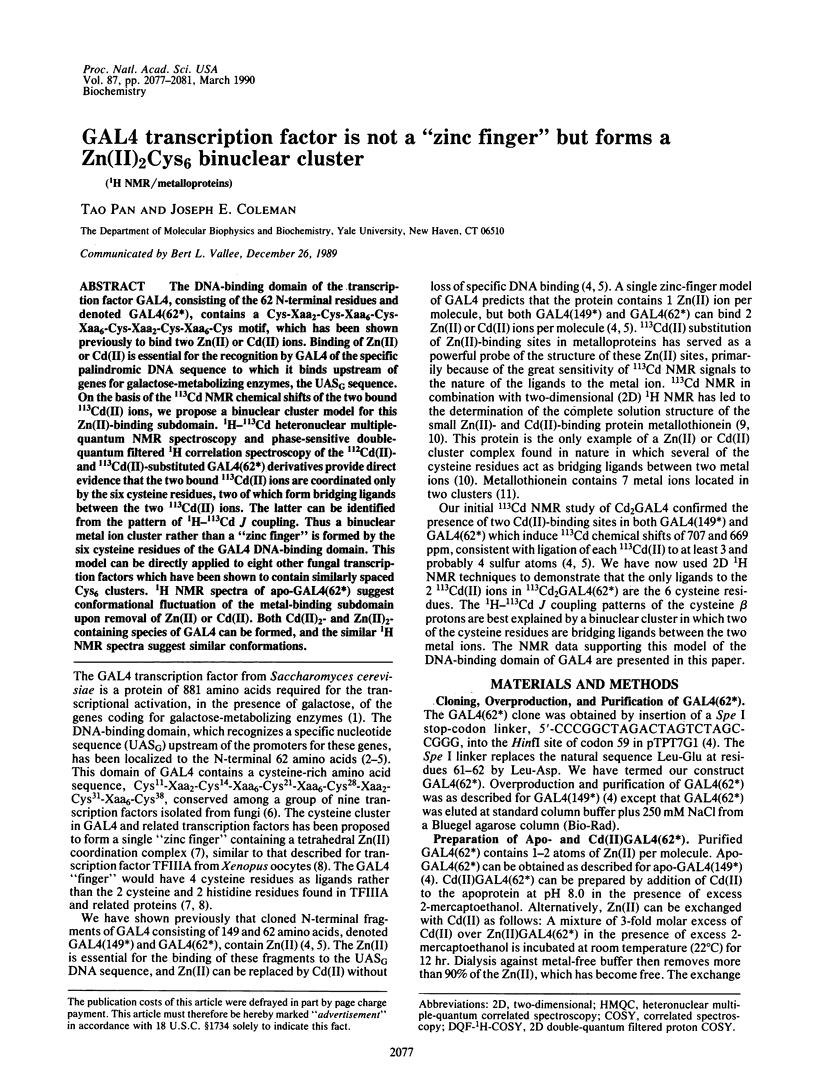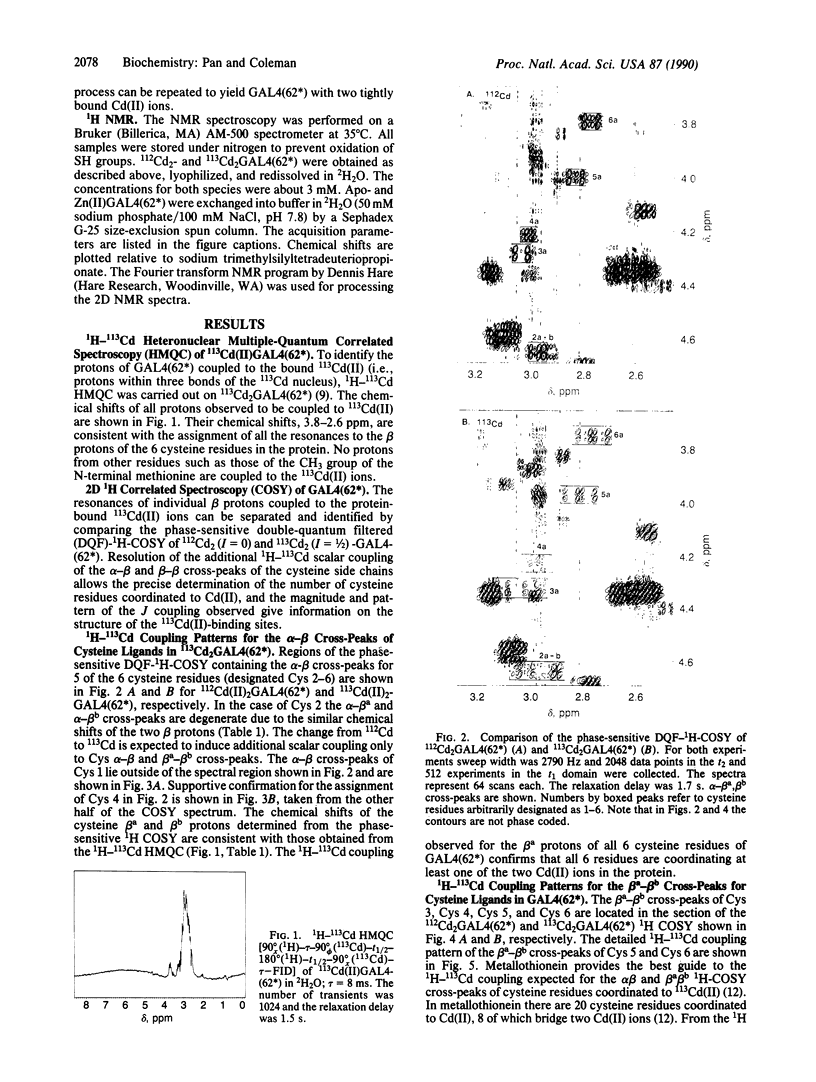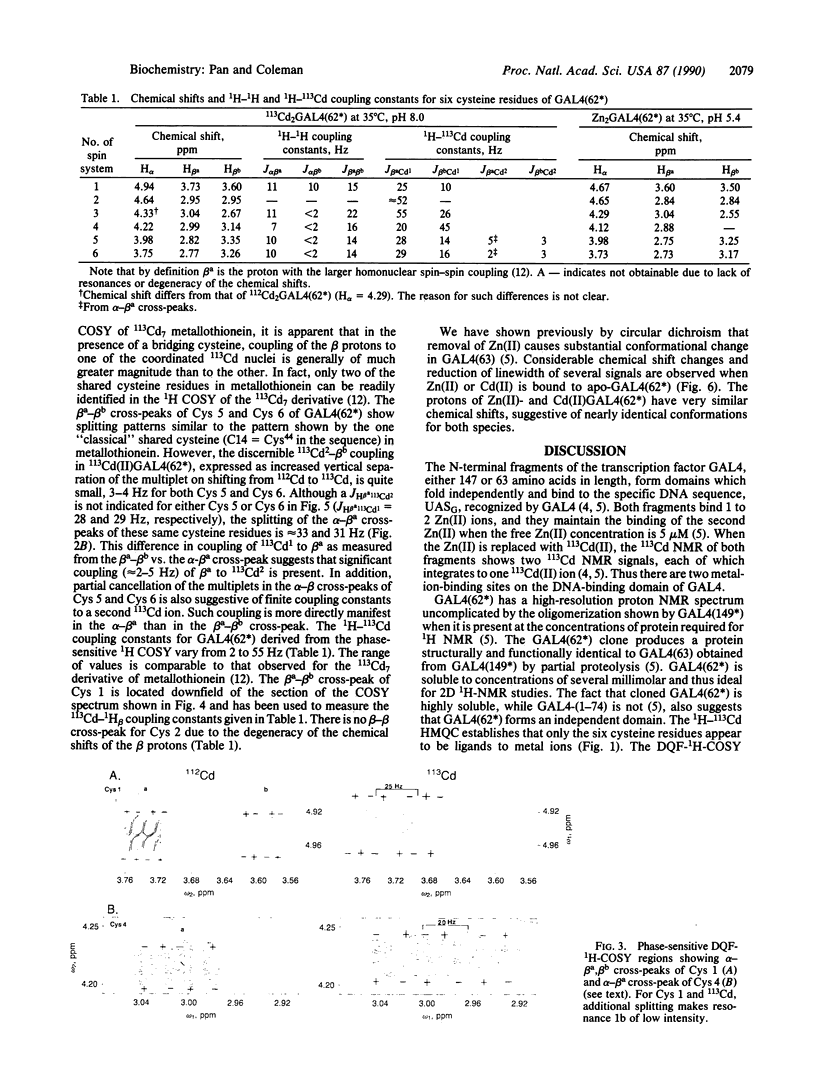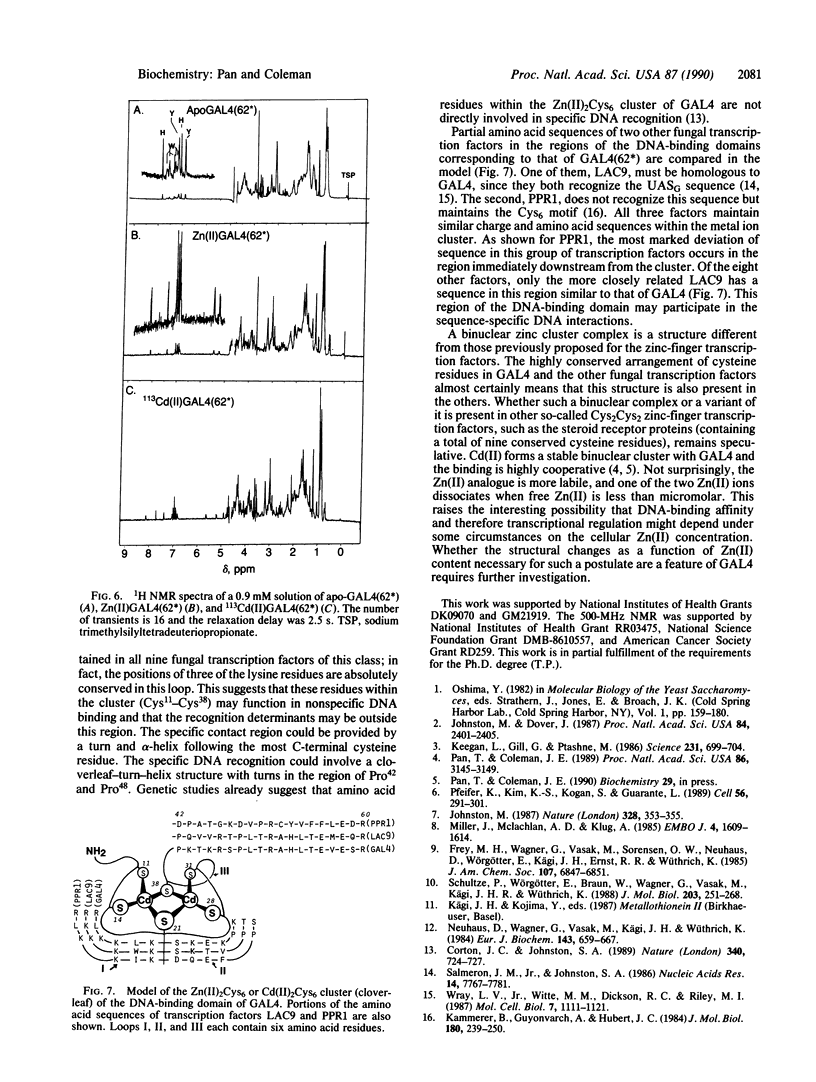Abstract
The DNA-binding domain of the transcription factor GAL4, consisting of the 62 N-terminal residues and denoted GAL4(62*), contains a Cys-Xaa2-Cys-Xaa6-Cys-Xaa6-Cys-Xaa2-Cys-Xaa6+ ++-Cys motif, which has been shown previously to bind two Zn(II) or Cd(II) ions. Binding of Zn(II) or Cd(II) is essential for the recognition by GAL4 of the specific palindromic DNA sequence to which it binds upstream of genes for galactose-metabolizing enzymes, the UASG sequence. On the basis of the 113Cd NMR chemical shifts of the two bound 113Cd(II) ions, we propose a binuclear cluster model for this Zn(II)-binding subdomain. 1H-113Cd heteronuclear multiple-quantum NMR spectroscopy and phase-sensitive double-quantum filtered 1H correlation spectroscopy of the 112Cd(II)- and 113Cd(II)-substituted GAL4(62*) derivatives provide direct evidence that the two bound 113Cd(II) ions are coordinated only by the six cysteine residues, two of which form bridging ligands between the two 113Cd(II) ions. The latter can be identified from the pattern of 1H-113Cd J coupling. Thus a binuclear metal ion cluster rather than a "zinc finger" is formed by the six cysteine residues of the GAL4 DNA-binding domain. This model can be directly applied to eight other fungal transcription factors which have been shown to contain similarly spaced Cys6 clusters. 1H NMR spectra of apo-GAL4(62*) suggest conformational fluctuation of the metal-binding subdomain upon removal of Zn(II) or Cd(II). Both Cd(II)2- and Zn(II)2-containing species of GAL4 can be formed, and the similar 1H NMR spectra suggest similar conformations.
Full text
PDF




Images in this article
Selected References
These references are in PubMed. This may not be the complete list of references from this article.
- Corton J. C., Johnston S. A. Altering DNA-binding specificity of GAL4 requires sequences adjacent to the zinc finger. Nature. 1989 Aug 31;340(6236):724–727. doi: 10.1038/340724a0. [DOI] [PubMed] [Google Scholar]
- Johnston M., Dover J. Mutations that inactivate a yeast transcriptional regulatory protein cluster in an evolutionarily conserved DNA binding domain. Proc Natl Acad Sci U S A. 1987 Apr;84(8):2401–2405. doi: 10.1073/pnas.84.8.2401. [DOI] [PMC free article] [PubMed] [Google Scholar]
- Johnston M. Genetic evidence that zinc is an essential co-factor in the DNA binding domain of GAL4 protein. Nature. 1987 Jul 23;328(6128):353–355. doi: 10.1038/328353a0. [DOI] [PubMed] [Google Scholar]
- Kammerer B., Guyonvarch A., Hubert J. C. Yeast regulatory gene PPR1. I. Nucleotide sequence, restriction map and codon usage. J Mol Biol. 1984 Dec 5;180(2):239–250. doi: 10.1016/s0022-2836(84)80002-9. [DOI] [PubMed] [Google Scholar]
- Keegan L., Gill G., Ptashne M. Separation of DNA binding from the transcription-activating function of a eukaryotic regulatory protein. Science. 1986 Feb 14;231(4739):699–704. doi: 10.1126/science.3080805. [DOI] [PubMed] [Google Scholar]
- Miller J., McLachlan A. D., Klug A. Repetitive zinc-binding domains in the protein transcription factor IIIA from Xenopus oocytes. EMBO J. 1985 Jun;4(6):1609–1614. doi: 10.1002/j.1460-2075.1985.tb03825.x. [DOI] [PMC free article] [PubMed] [Google Scholar]
- Neuhaus D., Wagner G., Vasák M., Kägi J. H., Wüthrich K. 113CD-1H spin-spin couplings in homonuclear 1H correlated spectroscopy of metallothionein. Identification of the cysteine 1H spin systems. Eur J Biochem. 1984 Sep 17;143(3):659–667. doi: 10.1111/j.1432-1033.1984.tb08419.x. [DOI] [PubMed] [Google Scholar]
- Pan T., Coleman J. E. Structure and function of the Zn(II) binding site within the DNA-binding domain of the GAL4 transcription factor. Proc Natl Acad Sci U S A. 1989 May;86(9):3145–3149. doi: 10.1073/pnas.86.9.3145. [DOI] [PMC free article] [PubMed] [Google Scholar]
- Pfeifer K., Kim K. S., Kogan S., Guarente L. Functional dissection and sequence of yeast HAP1 activator. Cell. 1989 Jan 27;56(2):291–301. doi: 10.1016/0092-8674(89)90903-3. [DOI] [PubMed] [Google Scholar]
- Salmeron J. M., Jr, Johnston S. A. Analysis of the Kluyveromyces lactis positive regulatory gene LAC9 reveals functional homology to, but sequence divergence from, the Saccharomyces cerevisiae GAL4 gene. Nucleic Acids Res. 1986 Oct 10;14(19):7767–7781. doi: 10.1093/nar/14.19.7767. [DOI] [PMC free article] [PubMed] [Google Scholar]
- Schultze P., Wörgötter E., Braun W., Wagner G., Vasák M., Kägi J. H., Wüthrich K. Conformation of [Cd7]-metallothionein-2 from rat liver in aqueous solution determined by nuclear magnetic resonance spectroscopy. J Mol Biol. 1988 Sep 5;203(1):251–268. doi: 10.1016/0022-2836(88)90106-4. [DOI] [PubMed] [Google Scholar]
- Wray L. V., Jr, Witte M. M., Dickson R. C., Riley M. I. Characterization of a positive regulatory gene, LAC9, that controls induction of the lactose-galactose regulon of Kluyveromyces lactis: structural and functional relationships to GAL4 of Saccharomyces cerevisiae. Mol Cell Biol. 1987 Mar;7(3):1111–1121. doi: 10.1128/mcb.7.3.1111. [DOI] [PMC free article] [PubMed] [Google Scholar]







